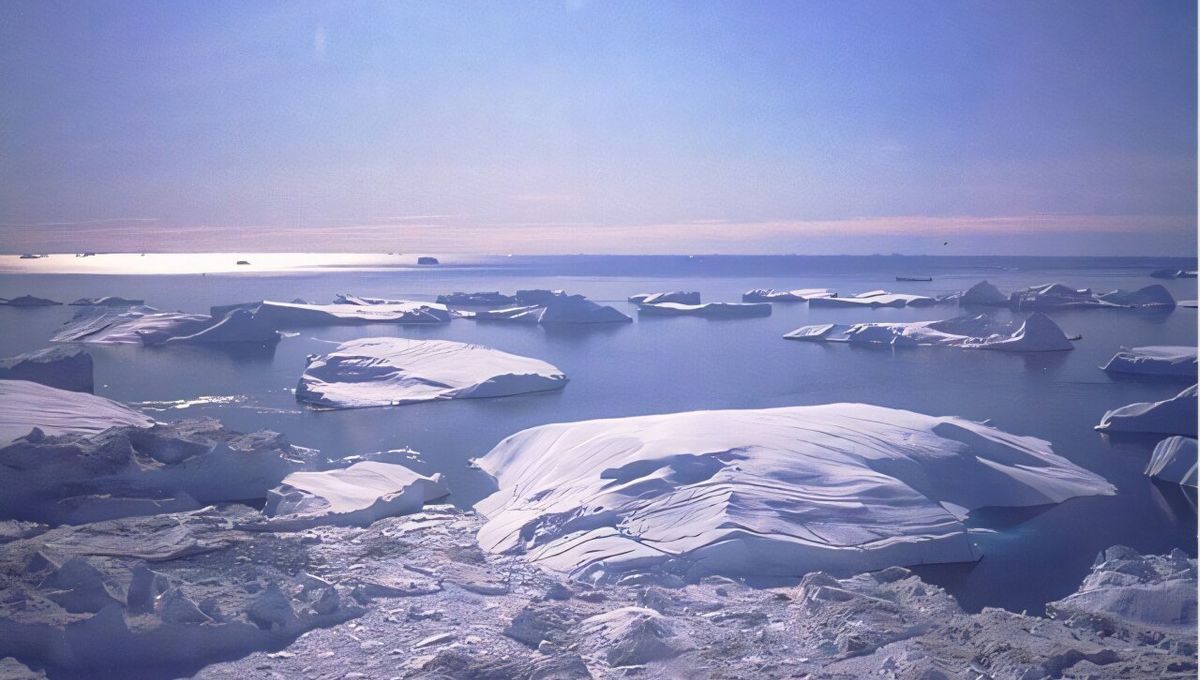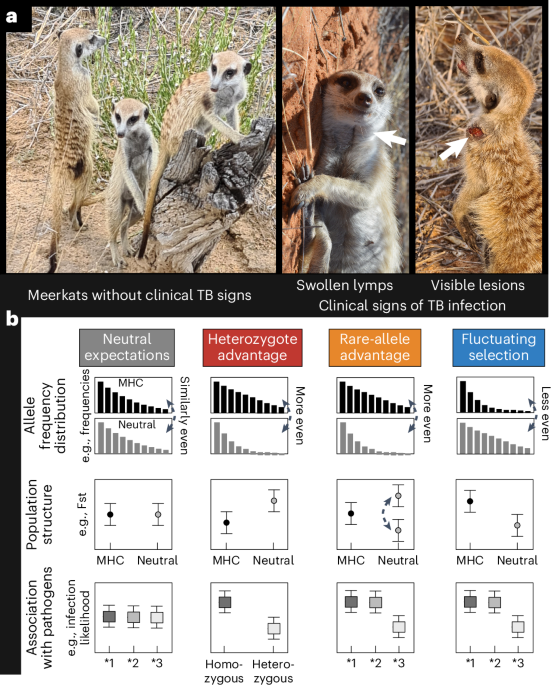Fijarczyk, A. & Babik, W. Detecting balancing selection in genomes: limits and prospects. Mol. Ecol. 24, 3529–3545 (2015).
CAS
PubMed
Google Scholar
Kloch, A. et al. Signatures of balancing selection in toll-like receptor (TLRs) genes—novel insights from a free-living rodent. Sci. Rep. 8, 8361 (2018).
PubMed
PubMed Central
Google Scholar
Quéméré, E. et al. Pathogen‐mediated selection favours the maintenance of innate immunity gene polymorphism in a widespread wild ungulate. J. Evol. Biol. 34, 1156–1166 (2021).
PubMed
Google Scholar
Wegner, K. M., Kalbe, M., Kurtz, J., Reusch, T. B. H. & Milinski, M. Parasite selection for immunogenetic optimality. Science 301, 1343 (2003).
CAS
PubMed
Google Scholar
Wroblewski, E. E. et al. Malaria-driven adaptation of MHC class I in wild bonobo populations. Nat. Commun. 14, 1033 (2023).
CAS
PubMed
PubMed Central
Google Scholar
Radwan, J., Babik, W., Kaufman, J., Lenz, T. L. & Winternitz, J. Advances in the evolutionary understanding of MHC polymorphism. Trends Genet. 36, 298–311 (2020).
CAS
PubMed
Google Scholar
Sommer, S. The importance of immune gene variability (MHC) in evolutionary ecology and conservation. Front. Zool. 2, 16 (2005).
PubMed
PubMed Central
Google Scholar
Kaufman, J. Unfinished business: evolution of the MHC and the adaptive immune system of jawed vertebrates. Annu. Rev. Immunol. 36, 383–409 (2018).
CAS
PubMed
Google Scholar
Spurgin, L. G. & Richardson, D. S. How pathogens drive genetic diversity: MHC, mechanisms and misunderstandings. Proc. R. Soc. B 277, 979–988 (2010).
CAS
PubMed
PubMed Central
Google Scholar
Takahata, N. & Nei, M. Allelic genealogy under overdominant and frequency-dependent selection and polymorphism of major histocompatibility complex loci. Genetics 124, 967–978 (1990).
CAS
PubMed
PubMed Central
Google Scholar
Borghans, J. A. M., Beltman, J. B. & De Boer, R. J. MHC polymorphism under host–pathogen coevolution. Immunogenetics 55, 732–739 (2004).
CAS
PubMed
Google Scholar
Eizaguirre, C., Lenz, T. L., Kalbe, M. & Milinski, M. Rapid and adaptive evolution of MHC genes under parasite selection in experimental vertebrate populations. Nat. Commun. 3, 621 (2012).
PubMed
Google Scholar
Kubinak, J. L., Ruff, J. S., Hyzer, C. W., Slev, P. R. & Potts, W. K. Experimental viral evolution to specific host MHC genotypes reveals fitness and virulence trade-offs in alternative MHC types. Proc. Natl Acad. Sci. USA 109, 3422–3427 (2012).
CAS
PubMed
PubMed Central
Google Scholar
Phillips, K. P. et al. Immunogenetic novelty confers a selective advantage in host–pathogen coevolution. Proc. Natl Acad. Sci. USA 115, 1552–1557 (2018).
CAS
PubMed
PubMed Central
Google Scholar
Bolnick, D. I. & Stutz, W. E. Frequency dependence limits divergent evolution by favouring rare immigrants over residents. Nature 546, 285–288 (2017).
CAS
PubMed
Google Scholar
Schmid, D. W. et al. MHC class II genes mediate susceptibility and resistance to coronavirus infections in bats. Mol. Ecol. 32, 3989–4002 (2023).
CAS
PubMed
Google Scholar
Bonneaud, C., Perez-Tris, J., Federici, P., Chastel, O. & Sorci, G. Major histocompatibility alleles associated with local resistance to malaria in a passerine. Evolution 60, 383–389 (2006).
CAS
PubMed
Google Scholar
Brisson, D. Negative frequency-dependent selection is frequently confounding. Front. Ecol. Evol. 6, 10 (2018).
PubMed
PubMed Central
Google Scholar
Bernatchez, L. & Landry, C. MHC studies in nonmodel vertebrates: what have we learned about natural selection in 15 years? J. Evol. Biol. 16, 363–377 (2003).
CAS
PubMed
Google Scholar
Oliver, M. K., Lambin, X., Cornulier, T. & Piertney, S. B. Spatio-temporal variation in the strength and mode of selection acting on major histocompatibility complex diversity in water vole (Arvicola terrestris) metapopulations. Mol. Ecol. 18, 80–92 (2009).
CAS
PubMed
Google Scholar
Acevedo-Whitehouse, K., Gulland, F. M. & Bowen, L. MHC class II DRB diversity predicts antigen recognition and is associated with disease severity in California sea lions naturally infected with Leptospira interrogans. Infect. Genet. Evol. 57, 158–165 (2018).
CAS
PubMed
Google Scholar
Lenz, T. L., Wells, K., Pfeiffer, M. & Sommer, S. Diverse MHC IIB allele repertoire increases parasite resistance and body condition in the long-tailed giant rat (Leopoldamys sabanus). BMC Evol. Biol. 9, 269 (2009).
PubMed
PubMed Central
Google Scholar
Oliver, M. K., Telfer, S. & Piertney, S. B. Major histocompatibility complex (MHC) heterozygote superiority to natural multi-parasite infections in the water vole (Arvicola terrestris). Proc. R. Soc. B 276, 1119–1128 (2008).
PubMed Central
Google Scholar
Eizaguirre, C., Lenz, T. L., Kalbe, M. & Milinski, M. Divergent selection on locally adapted major histocompatibility complex immune genes experimentally proven in the field. Ecol. Lett. 15, 723–731 (2012).
PubMed
PubMed Central
Google Scholar
Landry, C. & Bernatchez, L. Comparative analysis of population structure across environments and geographical scales at major histocompatibility complex and microsatellite loci in Atlantic salmon (Salmo salar). Mol. Ecol. 10, 2525–2539 (2001).
CAS
PubMed
Google Scholar
Ejsmond, M. J. & Radwan, J. Red Queen processes drive positive selection on major histocompatibility complex (MHC) genes. PLoS Comput. Biol. 11, e1004627 (2015).
PubMed
PubMed Central
Google Scholar
Ejsmond, M. J., Babik, W. & Radwan, J. MHC allele frequency distributions under parasite-driven selection: a simulation model. BMC Evol. Biol. 10, 332 (2010).
PubMed
PubMed Central
Google Scholar
Westerdahl, H., Hansson, B., Bensch, S. & Hasselquist, D. Between‐year variation of MHC allele frequencies in great reed warblers: selection or drift? J. Evol. Biol. 17, 485–492 (2004).
CAS
PubMed
Google Scholar
Charbonnel, N. & Pemberton, J. A long-term genetic survey of an ungulate population reveals balancing selection acting on MHC through spatial and temporal fluctuations in selection. Heredity 95, 377–388 (2005).
CAS
PubMed
Google Scholar
Global Tuberculosis Report 2023 (Global Tuberculosis Programme, 2023).
Reis, A. C., Ramos, B., Pereira, A. C. & Cunha, M. V. The hard numbers of tuberculosis epidemiology in wildlife: a meta‐regression and systematic review. Transbound. Emerg. Dis. 68, 3257–3276 (2021).
PubMed
Google Scholar
Fernandez-de-Mera, I. G. et al. Impact of major histocompatibility complex class II polymorphisms on Iberian red deer parasitism and life history traits. Infect. Genet. Evol. 9, 1232–1239 (2009).
CAS
PubMed
Google Scholar
Galindo, R. C. et al. Gene expression profiles of European wild boar naturally infected with Mycobacterium bovis. Vet. Immunol. Immunopathol. 129, 119–125 (2009).
CAS
PubMed
Google Scholar
Sveinbjornsson, G. et al. HLA class II sequence variants influence tuberculosis risk in populations of European ancestry. Nat. Genet. 48, 318–322 (2016).
CAS
PubMed
PubMed Central
Google Scholar
Waters, W. et al. MHC class II-restricted, CD4+ T-cell proliferative responses of peripheral blood mononuclear cells from Mycobacterium bovis-infected white-tailed deer. Vet. Immunol. Immunopathol. 76, 215–229 (2000).
CAS
PubMed
Google Scholar
Clutton-Brock, T. & Manser, M. in Cooperative Breeding in Vertebrates: Studies of Ecology, Evolution, and Behavior (eds Koenig, W. D. & Dickinson, J. L.) 294–317 (Cambridge Univ. Press, 2016); https://doi.org/10.1017/CBO9781107338357.018
Young, A. J. et al. Stress and the suppression of subordinate reproduction in cooperatively breeding meerkats. Proc. Natl Acad. Sci. USA 103, 12005–12010 (2006).
CAS
PubMed
PubMed Central
Google Scholar
Dyble, M., Houslay, T. M., Manser, M. B. & Clutton-Brock, T. Intergroup aggression in meerkats. Proc. R. Soc. B 286, 20191993 (2019).
PubMed
PubMed Central
Google Scholar
Müller‐Klein, N. et al. Two decades of tuberculosis surveillance reveal disease spread, high levels of exposure and mortality and marked variation in disease progression in wild meerkats. Transbound. Emerg. Dis. 69, 3274–3284 (2022).
PubMed
Google Scholar
Parsons, S. D. C., Drewe, J. A., Gey Van Pittius, N. C., Warren, R. M. & Van Helden, P. D. Novel cause of tuberculosis in meerkats, South Africa. Emerg. Infect. Dis. 19, 2004–2007 (2013).
PubMed
PubMed Central
Google Scholar
Drewe, J. A. Who infects whom? Social networks and tuberculosis transmission in wild meerkats. Proc. Biol. Sci. 277, 633–642 (2010).
PubMed
Google Scholar
Donadio, J. et al. Characterizing tuberculosis progression in wild meerkats (Suricata suricatta) from fecal samples and clinical signs. J. Wildl. Dis. 58, 309–321 (2022).
PubMed
Google Scholar
Drewe, J. A., Foote, A. K., Sutcliffe, R. L. & Pearce, G. P. Pathology of Mycobacterium bovis infection in wild meerkats (Suricata suricatta). J. Comp. Pathol. 140, 12–24 (2009).
CAS
PubMed
Google Scholar
Migalska, M. et al. Long term patterns of association between MHC and helminth burdens in the bank vole support Red Queen dynamics. Mol. Ecol. 31, 3400–3415 (2022).
CAS
PubMed
PubMed Central
Google Scholar
Huang, W. et al. Contemporary selection on MHC genes in a free‐living ruminant population. Ecol. Lett. 25, 828–838 (2022).
PubMed
PubMed Central
Google Scholar
Hess, C. M., Wang, Z. & Edwards, S. V. Evolutionary genetics of Carpodacus mexicanus, a recently colonized host of a bacterial pathogen, Mycoplasma gallisepticum. Genetica 129, 217–225 (2007).
PubMed
Google Scholar
Winternitz, J. C., Wares, J. P., Yabsley, M. J. & Altizer, S. Wild cyclic voles maintain high neutral and MHC diversity without strong evidence for parasite-mediated selection. Evol. Ecol. 28, 957–975 (2014).
Google Scholar
Fraser, B. A., Ramnarine, I. W. & Neff, B. D. Temporal variation at the MHC class IIb in wild populations of the guppy (Poecilia reticulata). Evolution 64, 2086–2096 (2010).
PubMed
Google Scholar
Brouwer, L. et al. MHC-dependent survival in a wild population: evidence for hidden genetic benefits gained through extra-pair fertilizations. Mol. Ecol. 19, 3444–3455 (2010).
PubMed
Google Scholar
Worley, K. et al. MHC heterozygosity and survival in red junglefowl. Mol. Ecol. 19, 3064–3075 (2010).
PubMed
Google Scholar
Savage, A. E., Mulder, K. P., Torres, T. & Wells, S. Lost but not forgotten: MHC genotypes predict overwinter survival despite depauperate MHC diversity in a declining frog. Conserv. Genet. 19, 309–322 (2018).
CAS
Google Scholar
Kloch, A., Baran, K., Buczek, M., Konarzewski, M. & Radwan, J. MHC influences infection with parasites and winter survival in the root vole Microtus oeconomus. Evol. Ecol. 27, 635–653 (2013).
Google Scholar
Sauermann, U. et al. Mhc class I haplotypes associated with survival time in simian immunodeficiency virus (SIV)-infected rhesus macaques. Genes Immun. 9, 69–80 (2008).
CAS
PubMed
Google Scholar
Chandra, P., Grigsby, S. J. & Philips, J. A. Immune evasion and provocation by Mycobacterium tuberculosis. Nat. Rev. Microbiol. 20, 750–766 (2022).
CAS
PubMed
PubMed Central
Google Scholar
de Martino, M., Lodi, L., Galli, L. & Chiappini, E. Immune response to Mycobacterium tuberculosis: a narrative review. Front. Pediatr. 7, 350 (2019).
PubMed
PubMed Central
Google Scholar
Ferluga, J., Yasmin, H., Al-Ahdal, M. N., Bhakta, S. & Kishore, U. Natural and trained innate immunity against Mycobacterium tuberculosis. Immunobiology 225, 151951 (2020).
CAS
PubMed
Google Scholar
Ndong Sima, C. A. A. et al. The immunogenetics of tuberculosis (TB) susceptibility. Immunogenetics 75, 215–230 (2023).
PubMed
Google Scholar
Orme, I. M., Robinson, R. T. & Cooper, A. M. The balance between protective and pathogenic immune responses in the TB-infected lung. Nat. Immunol. 16, 57–63 (2015).
CAS
PubMed
Google Scholar
Kalbe, M. et al. Lifetime reproductive success is maximized with optimal major histocompatibility complex diversity. Proc. R. Soc. B 276, 925–934 (2008).
PubMed Central
Google Scholar
Canal, D. et al. MHC class II supertypes affect survival and lifetime reproductive success in a migratory songbird. Mol. Ecol. 33, e17554 (2024).
CAS
PubMed
Google Scholar
Sepil, I., Lachish, S. & Sheldon, B. C. MHC-linked survival and lifetime reproductive success in a wild population of great tits. Mol. Ecol. 22, 384–396 (2013).
PubMed
Google Scholar
Paterson, S., Wilson, K. & Pemberton, J. M. Major histocompatibility complex variation associated with juvenile survival and parasite resistance in a large unmanaged ungulate population (Ovis aries L.). Proc. Natl Acad. Sci. USA 95, 3714–3719 (1998).
CAS
PubMed
PubMed Central
Google Scholar
Arora, J. et al. HLA heterozygote advantage against HIV-1 is driven by quantitative and qualitative differences in HLA allele-specific peptide presentation. Mol. Biol. Evol. 37, 639–650 (2020).
CAS
PubMed
Google Scholar
Froeschke, G. & Sommer, S. MHC class II DRB variability and parasite load in the striped mouse (Rhabdomys pumilio) in the Southern Kalahari. Mol. Biol. Evol. 22, 1254–1259 (2005).
CAS
PubMed
Google Scholar
Dippenaar, A. et al. Whole genome sequence analysis of Mycobacterium suricattae. Tuberculosis 95, 682–688 (2015).
CAS
PubMed
Google Scholar
Olayemi, A. et al. MHC-I alleles mediate clearance and antibody response to the zoonotic Lassa virus in Mastomys rodent reservoirs. PLoS Negl. Trop. Dis. 18, e0011984 (2024).
CAS
PubMed
PubMed Central
Google Scholar
Schad, J., Dechmann, D. K., Voigt, C. C. & Sommer, S. Evidence for the ‘good genes’ model: association of MHC class II DRB alleles with ectoparasitism and reproductive state in the neotropical lesser bulldog bat, Noctilio albiventris. PLoS ONE 7, e37101 (2012).
CAS
PubMed
PubMed Central
Google Scholar
Westerdahl, H. et al. Associations between malaria and MHC genes in a migratory songbird. Proc. R. Soc. B 272, 1511–1518 (2005).
CAS
PubMed
PubMed Central
Google Scholar
Fleischer, R. et al. Immunogenetic-pathogen networks shrink in Tome’s spiny rat, a generalist rodent inhabiting disturbed landscapes. Commun. Biol. 7, 1–11 (2024).
Google Scholar
Alexander, K. A. et al. Emerging tuberculosis pathogen hijacks social communication behavior in the group-living banded mongoose (Mungos mungo). mBio https://doi.org/10.1128/mbio.00281-16 (2016).
Patterson, S., Drewe, J. A., Pfeiffer, D. U. & Clutton‐Brock, T. H. Social and environmental factors affect tuberculosis related mortality in wild meerkats. J. Anim. Ecol. 86, 442–450 (2017).
PubMed
PubMed Central
Google Scholar
Mares, R., Bateman, A. W., English, S., Clutton-Brock, T. H. & Young, A. J. Timing of predispersal prospecting is influenced by environmental, social and state-dependent factors in meerkats. Anim. Behav. 88, 185–193 (2014).
Google Scholar
Maag, N., Cozzi, G., Clutton-Brock, T. & Ozgul, A. Density-dependent dispersal strategies in a cooperative breeder. Ecology 99, 1932–1941 (2018).
PubMed
Google Scholar
Paniw, M. et al. Higher temperature extremes exacerbate negative disease effects in a social mammal. Nat. Clim. Chang. 12, 284–290 (2022).
Google Scholar
Paniw, M., Maag, N., Cozzi, G., Clutton-Brock, T. & Ozgul, A. Life history responses of meerkats to seasonal changes in extreme environments. Science 363, 631–635 (2019).
CAS
PubMed
Google Scholar
Risely, A. et al. Climate change drives loss of bacterial gut mutualists at the expense of host survival in wild meerkats. Glob. Change Biol. 29, 5816–5828 (2023).
CAS
Google Scholar
Alexander, K. A., Sanderson, C. E. & Laver, P. N. in Tuberculosis, Leprosy and Mycobacterial Diseases of Man and Animals: The Many Hosts of Mycobacteria (eds Mukundan, H. et al.) 386–401 (CABI, 2015); https://doi.org/10.1079/9781780643960.0386
Gortázar, C., De La Fuente, J., Perelló, A. & Domínguez, L. Will we ever eradicate animal tuberculosis? Ir. Vet. J. 76, 24 (2023).
PubMed
PubMed Central
Google Scholar
Thorley, J., Duncan, C., Gaynor, D., Manser, M. B. & Clutton-Brock, T. Disentangling the effects of temperature and rainfall on the population dynamics of Kalahari meerkats. Oikos 2025, e10988 (2025).
Google Scholar
Duncan, C., Manser, M. B. & Clutton‐Brock, T. Decline and fall: the causes of group failure in cooperatively breeding meerkats. Ecol. Evol. 11, 14459–14474 (2021).
PubMed
PubMed Central
Google Scholar
Van de Ven, T. M., Fuller, A. & Clutton‐Brock, T. H. Effects of climate change on pup growth and survival in a cooperative mammal, the meerkat. Funct. Ecol. 34, 194–202 (2020).
Google Scholar
Kutsukake, N. & Clutton-Brock, T. H. The number of subordinates moderates intrasexual competition among males in cooperatively breeding meerkats. Proc. R. Soc. B 275, 209–216 (2007).
PubMed Central
Google Scholar
Clutton‐Brock, T. et al. Reproduction and survival of suricates (Suricata suricatta) in the southern Kalahari. Afr. J. Eco 37, 69–80 (1999).
Google Scholar
Nielsen, J. F. et al. Inbreeding and inbreeding depression of early life traits in a cooperative mammal. Mol. Ecol. 21, 2788–2804 (2012).
PubMed
Google Scholar
Spong, G. F., Hodge, S. J., Young, A. J. & Clutton‐Brock, T. H. Factors affecting the reproductive success of dominant male meerkats. Mol. Ecol. 17, 2287–2299 (2008).
PubMed
Google Scholar
Coulon, A. GENHET: an easy‐to‐use R function to estimate individual heterozygosity. Mol. Ecol. Resour. 10, 167–169 (2010).
CAS
PubMed
Google Scholar
Gillingham, M. A. et al. A novel workflow to improve genotyping of multigene families in wildlife species: an experimental set‐up with a known model system. Mol. Ecol. Resour. 21, 982–998 (2021).
CAS
PubMed
Google Scholar
Kim, D., Paggi, J. M., Park, C., Bennett, C. & Salzberg, S. L. Graph-based genome alignment and genotyping with HISAT2 and HISAT-genotype. Nat. Biotechnol. 37, 907–915 (2019).
CAS
PubMed
PubMed Central
Google Scholar
Dudchenko, O. et al. De novo assembly of the Aedes aegypti genome using Hi-C yields chromosome-length scaffolds. Science 356, 92–95 (2017).
CAS
PubMed
PubMed Central
Google Scholar
Dudchenko, O. et al. The Juicebox Assembly Tools module facilitates de novo assembly of mammalian genomes with chromosome-length scaffolds for under $1000. Preprint at bioRxiv https://doi.org/10.1101/254797 (2018).
Altschul, S. F., Gish, W., Miller, W., Myers, E. W. & Lipman, D. J. Basic local alignment search tool. J. Mol. Biol. 215, 403–410 (1990).
CAS
PubMed
Google Scholar
Silver, L. W. et al. A targeted approach to investigating immune genes of an iconic Australian marsupial. Mol. Ecol. 31, 3286–3303 (2022).
CAS
PubMed
PubMed Central
Google Scholar
Peel, E. et al. Best genome sequencing strategies for annotation of complex immune gene families in wildlife. GigaScience 11, giac100 (2022).
PubMed
PubMed Central
Google Scholar
Lighten, J. et al. Evolutionary genetics of immunological supertypes reveals two faces of the Red Queen. Nat. Commun. 8, 1294 (2017).
PubMed
PubMed Central
Google Scholar
Schwensow, N., Fietz, J., Dausmann, K. H. & Sommer, S. Neutral versus adaptive genetic variation in parasite resistance: importance of major histocompatibility complex supertypes in a free-ranging primate. Heredity 99, 265–277 (2007).
CAS
PubMed
Google Scholar
Sepil, I., Lachish, S., Hinks, A. E. & Sheldon, B. C. MHC supertypes confer both qualitative and quantitative resistance to avian malaria infections in a wild bird population. Proc. R. Soc. B 280, 20130134 (2013).
PubMed
PubMed Central
Google Scholar
Yang, Z. PAML 4: phylogenetic analysis by maximum likelihood. Mol. Biol. Evol. 24, 1586–1591 (2007).
CAS
PubMed
Google Scholar
Sandberg, M., Eriksson, L., Jonsson, J., Sjöström, M. & Wold, S. New chemical descriptors relevant for the design of biologically active peptides. A multivariate characterization of 87 amino acids. J. Med. Chem. 41, 2481–2491 (1998).
CAS
PubMed
Google Scholar
Jombart, T., Devillard, S. & Balloux, F. Discriminant analysis of principal components: a new method for the analysis of genetically structured populations. BMC Genet. 11, 94 (2010).
PubMed
PubMed Central
Google Scholar
Roved, J., Hansson, B., Stervander, M., Hasselquist, D. & Westerdahl, H. MHCtools—an R package for MHC high‐throughput sequencing data: genotyping, haplotype and supertype inference, and downstream genetic analyses in non‐model organisms. Mol. Ecol. Resour. 22, 2775–2792 (2022).
CAS
PubMed
PubMed Central
Google Scholar
Gaigher, A., Burri, R., San-Jose, L. M., Roulin, A. & Fumagalli, L. Lack of statistical power as a major limitation in understanding MHC-mediated immunocompetence in wild vertebrate populations. Mol. Ecol. 28, 5115–5132 (2019).
PubMed
Google Scholar
R Core Team. R: A Language and Environment for Statistical Computing (R Foundation for Statistical Computing, 2018).
Posit PBC. RStudio: integrated development environment for R. GitHub https://github.com/rstudio/rstudio (2012).
Wickham, H. ggplot2. WIREs Comput. Stat. 3, 180–185 (2011).
Google Scholar
Lüdecke, M. D. sjPlot: data visualization for statistics in social science. CRAN https://cran.r-project.org/package=sjPlot (2023).
Bartón, K. MuMIn: model selection and model averaging based on information criteria. CRAN https://cran.r-project.org/package=MuMIn (2018).
Müller-Klein, N. et al. Twenty-years of tuberculosis-driven selection shaped the evolution of meerkat MHC. Datasets and code. figshare https://doi.org/10.6084/m9.figshare.26172985 (2025).
Benjamini, Y. & Hochberg, Y. Controlling the false discovery rate: a practical and powerful approach to multiple testing. J. R. Stat. Soc. Ser. B 57, 289–300 (1995).
Google Scholar
Griffith, D. M., Veech, J. A. & Marsh, C. J. cooccur: probabilistic species co-occurrence analysis in R. J. Stat. Soft. 69, 1–17 (2016).
Google Scholar
Therneau, T. M. coxme: mixed effects Cox models. R Package v.2. CRAN https://cran.r-project.org/package=coxme (2015).








